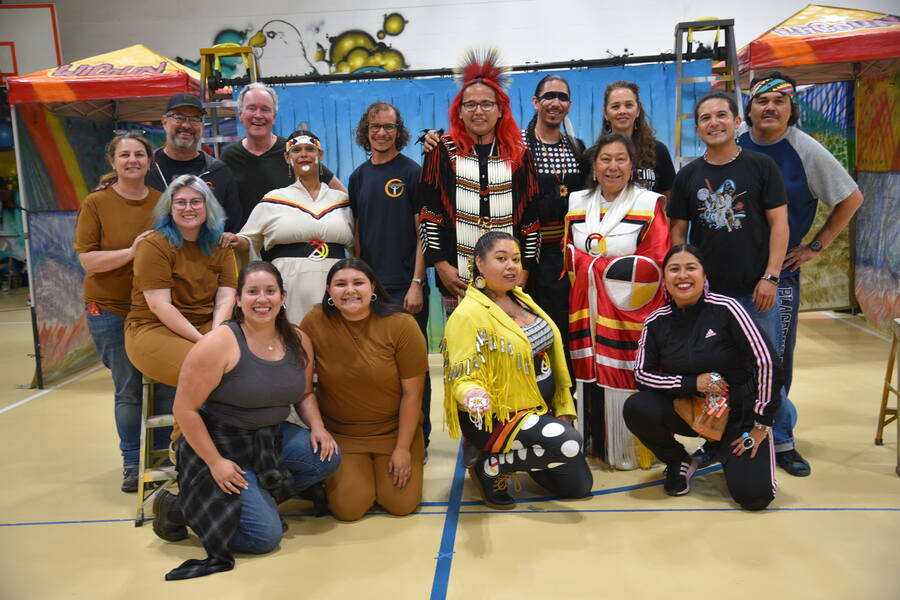In the first installment of this three-part story, we met Lakota playwright Larissa FastHorse, the Cornerstone Theater Ensemble, and the Oyate—i.e., the people of D/N/Lakota nations across what’s now known as South Dakota. In the second installment, we met the cast of Native performers and got to know a bit about the play, Wicoun, the story of Áya’s transition into a male superhero named Ahí. Now it all must come together and hold together—for a month and across 2,000 miles.
Touring Without a Net
May, 2023
At the heart of this story: More things go wrong, some tragic, some comic, some elemental.
Áya and Khoskala make it to Rapid City, and so does the show, Wicoun.
In Áya’s quest to become a superhero, the archenemies are, “Um, the same as everyone: Racism. Poverty. Drugs. Capitalism. Colonial societal structures. Destruction of the environment. Land back. Humidity.” Cornerstone’s obstacles, by contrast, seem pretty tame: wind, rain, lightning, noise, distance, last-minute confirmations from venue partners. Also humidity.
The whole time Wicoun is rehearsing in Placerville—and for months prior—the company tries to lock down performance sites and timing. It’s a small band touring, but trying to cover the whole state and hit almost all the reservations is still a massive undertaking. The play will ultimately perform in 17 venues across the state in 23 days, but just two weeks before the first show, only 10 are confirmed.
It’s notable that, in this ensemble context, every member of the Cornerstone Theater Company team understands every piece of the puzzle. The daily production meetings at Placerville involve Larissa as well as director Michael John Garcés, Cornerstone managing director Megan Wanlass, the designers, ensemble members Peter Howard and Kenny Ramos, company manager Paula Donnelly, as well as the production staff. The logistics are mind-bending: When will we have a second car? What if, on the day we reserved the only cargo van at the Rapid City Penske, it isn’t there? The hotel in Sioux City won’t return our calls; what if they won’t give us the group rate for our block of rooms? We’re 10 days…eight days…five days out, and (fill in the blank) won’t call back to confirm a performance!
Wicoun needs to rent each venue for four hours—90 minutes for arrival and load-in, 60 for strike—but no one’s sure yet how long the show will be. Seventy-five minutes? More? Less? What if they have to wait for audiences to arrive, especially on the Rez, where folks don’t work with the same urgency or on the same clock and where “curtain time” doesn’t mean shit? Where should flyers be dropped and posted in Crow Creek for people to see them—the two gas stations, the casino? Will people on the Rez respond to digital invitations? Is one performance venue, Little Wound in Kyle, preferable to another two miles away? “It’s only two miles, but gas costs money,” someone helpfully points out.
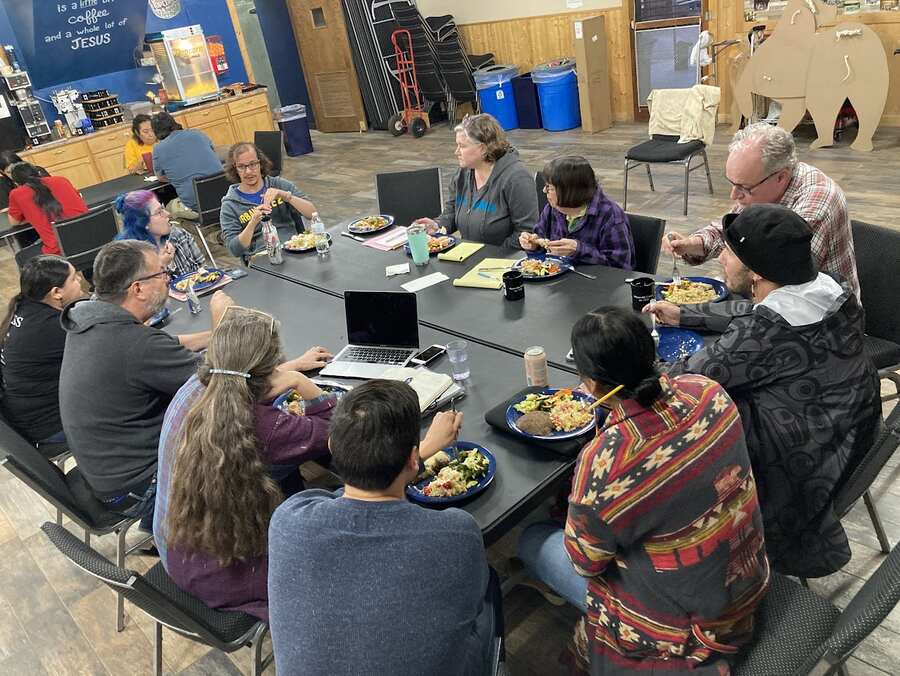
It seems like “divine providence” that sound designer Talon Bazille Ducheneaux joins one meeting that producer Michael Garcia encouraged him to “save himself” from: Talon’s partner has valuable connections in Okreek, plus a sister at Sinte Gleska University, where they’re hoping to perform but don’t have a strong contact. “Good luck getting anyone there unless you have a feed or grill off,” Talon cautions, echoing the warning of a comic nerd in the play who says, “Rule one when gathering Indians: There must be food.”
It’s hard enough to plan, but it’s impossible to create back up plans without understudies, equipped and weather-protected spaces, clear seating (though reservation folks are used to bringing their own camp chairs to gatherings), or presenting infrastructure at the venues. Will the weather gods return their calls?
The set-up on day two couldn’t be more different than in the bucolic Black Hills where they did the show’s first preview. The van and scenery fill the parking lot outside Racing Magpie, a small but mighty Lakota arts center and residency program in Rapid City, which put out the call out for local artists to work with the show. (Painter and retired Lakota language teacher Matt Uses Knife—Matthew—responded at his daughter’s urging). At Black Hills Playhouse the day before there were rolling forests; now there are rolling trucks, cars that slow on the street (or is it an alley?) to watch the show before driving on. Tables of local arts and crafts—jewelry, paintings, printed shirts, and tote bags—add to the feel of an urban art fair. The condenser on Papa’s Frybread Wagon, the food truck parked on one side of Racing Magpie, keeps running through much of the performance. Camp chairs mix with the folding ones Larissa and Michael fetch from inside the low-rise building. The actors need extra projection to get the sound out, and it’s harder to read the audience as city sounds drown their laughter. The wind is noisy too. Rural outdoor drama one day, street performance the next. This isn’t the kind of theatre that keeps life out behind four walls. It’s theatre whose very essence is to let life in.
Despite the challenges, there’s something so right about the Racing Magpie lot, like the way the set, adorned with graffiti artist Focus Smith’s spray-can art and Matthew’s landscape painting—together with the comic book signs and bold costumes and puppets—jibes with the wall mural covering the adjacent building. The sprawling city mural with stenciled letters and bison heads under the words “Oceti Sakowin Territory” offers visual counterpoint to the panoramic backdrops, horizons of a different color. This vibrant stylistic profusion is visible everywhere in these Native communities; on streets, in galleries, at outdoor fairs, alleyways, and powwows, you’ll see drawings, prints, paintings, photographs, quilts, beadwork, regalia, sculpture.
A word about scenic designer Nephelie Andonyadis’s work with local artists. Her first design project with Cornerstone, back in the mid-’90s, was part of a long engagement the ensemble had with the Watts section of Los Angeles. She was looking to do with design what Cornerstone did with story and performance: Engage the community in the making. Nephelie designed an all-white projection surface, then created workshop projects with 4-H Club kids and residents of a senior center in Watts. With the kids she made mandalas and foamcore mazes from stuff found at Materials for the Arts and “hauled around in the back of my car. We would walk in—30 kids in a room—share the set design, ask if they would help us make the set.” With the elders she made paper birds. She collected everything they made. The set became an installation made from “all of that.” The mandalas and mazes became the walls, and the birds the ceiling. “People came to see the play and they could find the piece of the set they had made,” she recalls.
This first project became the model for much that followed, right up to her work with Focus and Matthew on Wicoun. “It was me designing something and bringing materials and asking people to join in co-creation, so they could make a piece that was their own,” Nephelie explains.
Wicoun’s painted backdrop was Matthew’s idea from the start. As an older man, he didn’t connect to the comic book aspects of the play, but he instinctively knew there needed to be a backdrop of the Black Hills, the heart of Lakota culture and site of its creation myth. “I learned so much about the mountains from the way he chose to paint them,” Nephelie admits, adding that she also “learned a lot from the way Focus paints,” including the use of special paints and spray caps. His work is “all about representation and literally changing the environment and transforming the walls within which people in the community live. He thinks of it as transformative art. Wow.”
Like Larissa waiting for the script to emerge from the community, and professional actors “working alongside somebody who maybe hasn’t performed before but who is authentically right for their role,” Nephelie knows this work isn’t about her. It trains her for “letting go of ego and for not being at the center of it all, and for flexing and figuring out how to make it work and what’s really important.”
This process of community co-creation extends to other production elements as well. The show opens with a song commissioned from and sung by Tiana Spotted Thunder, a much-loved Lakota recording artist from Pine Ridge. Costume designer Jeanette Godoy turns to a Lakota Cultural Bearer named Anthony KȞaŋgi TȞaŋka to design the traditional regalia Áya dons to become Ahí. And though she draws on her own Mexican indigeneity as she goes, Jeanette consults with Oglala Lakota fashion designer Tosa Two Heart—who also happens to be Kenny’s best friend and the source of his finest threads—to get things right.
If words seem to have been lost in the city racket at Racing Magpie, an encounter after the show makes it clear they weren’t. An excited little girl, maybe 5 years old, approaches several performers in turn, her mother hanging back. She still has baby teeth on one side of her mouth and mostly gums on the other. She tells each actor the same story: She recently lost a tooth—and had a cavity! Her favorite part of the play was when Áya threatened the cousin-sibling children that if they didn’t go to sleep immediately, there’d be no Cheerios for a week, only oatmeal! And with no sugar! “No sugar!” the little girl repeats, giddy with delight. She imitates the horrified puppet children before they conk out to rescue themselves from that dreadful, unsweetened fate. She bursts out laughing each time she tells it: “No sugar!”
That night, after the Racing Magpie show, it rains. The next morning, production manager Ash Nichols and stage manager Maria V. Oliveira discover that the cargo van leaks. Rather than trying to wrangle another—Penske in Rapid offers just the one—the troops empty the van, find the suspected leak in the upper corner on the passenger side of the cargo bay, and cover the corner inside and out with tarps, also tarping everything cardboard—i.e., pretty much everything. The set pieces and puppets have stayed dry, but many of the costumes are soaked inside their hanging bags. Fortunately, there’s one more day at Placerville, so Jeanette, the designer who doubles as dresser for the tour, airs the clothes on the copious lodge porches. She irons and dries where possible.
Main Street, Rapid City
That evening, though, as the company arrives for another Rapid City performance—this time at Main Street Square in the center of town—several superhero costumes are still damp, a bad omen. I drive into town with Michael and Larissa, and when we arrive, the square is still full of families, kids playing in sprays from a water park on one side. Other company cars pull up and report having driven through rain. A few heavy drops spatter us. Soon we’re all staring at our phones, each with different weather apps, each with different forecasts, though almost all predict heavy thunderstorms between 6 and 8, the hours at which load-in begins and the show ends. The only contingency plan is cancellation, because with sets, props, and puppets made of cardboard, and no covering for the audience—their chairs will rest on Astroturf between a bandshell and the water playground—there’s no way to stay dry.
Company manager Paula Donnelly gathers us together on the bandstand, but everyone’s in wait-and-see mode. No one has an actual plan. Nephelie makes a proposal: Use the raised bandstand as a large backstage area. Lay the puppets on tarps over the cement platform instead of the usual tables. Cover them for now. Let the actors carefully climb and descend the steps to change clothes or grab props. Meantime, set everything up with sandbags and clamps.
Load-in begins, interrupted immediately by an emergency signal shrieking out of the square’s overhead speakers, warning of severe thunderstorms throughout the nearby counties, with winds up to 60 miles an hour. Michael says he’s “short on optimism and long on hope.” Everyone checks their apps again, calculating the chance and timing of rain and wind. Scenery, props, costumes, and sound equipment get unpacked and set. The clouds are dark and full, but the wind is calm and the chance of rain (on my phone at least) has fallen to 30 percent and shifted to 8 p.m., near the show’s end. Intrepid audience members gather in camp chairs and on blankets in the square. We track cloud movement and watch for breaks in the sky, praying this part of town catches one. At 6:55 my phone predicts thunderstorms starting in 13 minutes and lasting two hours.
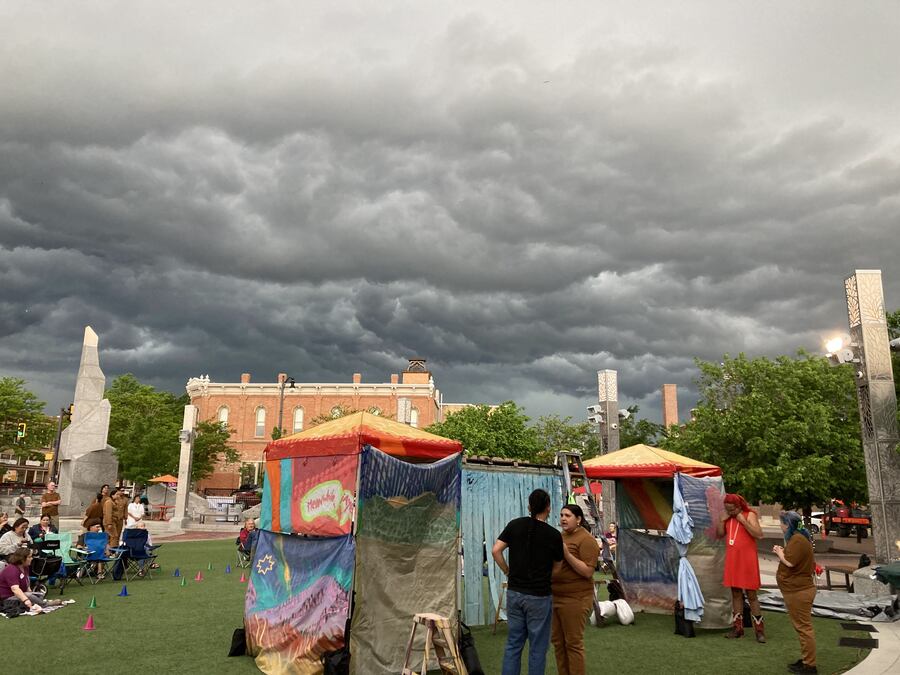
The performance begins, even as lightning intensifies in the distance and rolling thunder creates an ominous soundtrack under the opening chorus of hate toward the two-spirit cousins. Over my shoulder I hear Clementine Bordeaux say, “It’s tornado weather.” Right—we’re still in the Midwest, Toto.
More wind. Horizontal lightning rings the Main Street Square. Elder Superhero enters, slow-talking the zombie characters, and as the cousin-siblings Khoskalaka and Áya settle down to their schoolwork, the rain comes—first in a drizzle and then, after Michael calls hold, in a downpour. The audience packs to go, the pause becomes cancellation, and the company scrambles to cover the cardboard pieces and the sound equipment. Large hail falls next, bouncing off the cement plaza, and we all work to move the whole caboodle under the overhang. I climb a ladder and, with Kenny and Nephelie’s guidance, untie the backdrop curtain and unscrew the long pipe that holds it.
I’m afraid of the lightning. I think: This is how I’ll die, on a ladder in a storm at a Cornerstone show I’m here to chronicle, electrified on the highest point in the square clutching one end of a steel pipe while Kenny holds the other; the journey we began two years ago by traveling the state in the back of an SUV with Michael and Larissa up front will end with us both fried while striking the set in a storm in Rapid.
We don’t die. The scenery gets struck and brought to the concrete floor of the bandshell until there’s a lull, and, as one, the group decides to take advantage of the relative calm to haul the stuff to the truck in the alley behind us. We hand the damp everything up to Ash and Maria as they pack in as orderly a fashion as possible. And then it’s done, many hands making lightning work of it. The rain quiets.
Mark Valdez, Cornerstone’s exuberant board chair and artistic director of Mixed Blood in Minneapolis, who’s been catching real-time pictures of the rainy mayhem on social media, texts Michael to say, “At least the set isn’t made of cardboard!”
The Road to St. Francis
The next morning I will tag along for a youth workshop Larissa and Michael have planned in Crow Creek. It’s the first of several scheduled for the tour, a way to keep training, community-building, and empowerment going with young people, outreach to which Larissa has been devoted since she left the state for ballet school. It’s the kind of give-back Cornerstone has worked to provide since its infancy too: an ongoing, possibly lifelong relationship with places and people, not the extractive work sometimes called “engagement”—i.e., taking stories, talent, and resources from a place and offering a short-term, one-time return. We’ll leave at 7 a.m. and get breakfast on the way, at Michael’s favorite place in Rapid, Black Hills Bagels.
Around 6 p.m., I’m rewatching Stephen Ives and Michael Kantor’s Cornerstone: An Interstate Adventure, the inspiring 1999 documentary about the company’s early days. Larissa knocks on my door. Tomorrow morning’s workshop has been canceled without explanation.
At the kitchen sink after dinner, I talk to Brandon Sazue, the Hunkpati Dakota actor who plays three roles in Wicoun: comic book nerd Chris, a meth zombie, and Marcus the “Native Party Dude.” Brandon is from Crow Creek and is a three-time tribal chairman of the Crow Creek Sioux tribe. He speculates that the workshop was canceled for funerals tomorrow. There have been several deaths in that small Dakota community lately, including a teen suicide and an older friend of Brandon’s who drank himself to death. The last time he was there, two people he knew died in a car crash. The town tends to close down for funerals. I think of something his cast-mate Gina Project Celebrity Mallory said about personal loss on the drive to the Black Hills Playhouse some days before: “When you have a large family, you have to expect it.” This whole land of Native nations can feel like that—a large family in a state of almost continual, expected loss.
The next youth workshop takes a more comic turn toward cancellation. The morning after the Main Street rain-out, the company leaves Placerville for the Rosebud Quality Inn & Casino, 200 miles away on the western edge of Rosebud reservation. In the parking lot of the casino, you can physically step across the Nebraska state line into Valentine. A couple days later, Larissa, Michael, and I head to the St. Francis Indian School for theatre games and a playwriting workshop. A large, modern K-12 campus rooted in Lakota values and language, St. Francis was originally affiliated with the Catholic mission where we met Harold Compton two years before. Unlike on our earlier visit, in which we took a Jeep, we’re driving a Toyota Camry—the first time in years the creative duo hasn’t had a four-wheel-drive vehicle. We make the mistake of following Google Maps and turn off the highway onto an unpaved road that alternates dirt with gravel, wet from storms the night before. Then we hit sand. Not quicksand, but the kind of soft sand you sink into, and, without the right kind of car, stay sunk.
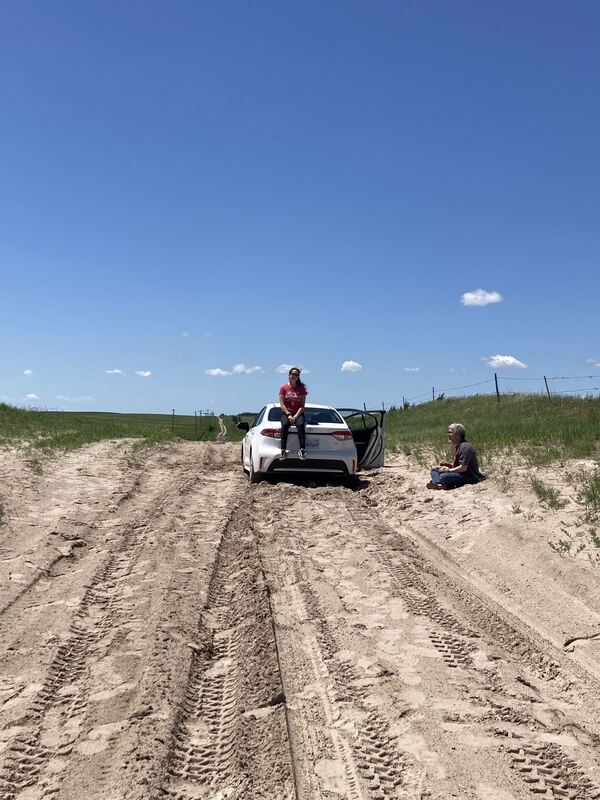
Michael and I push while Larissa revs. Larissa and I push while Michael rocks. Remembering lessons from the Chicago snowstorms of my youth, I drive while they push. We find a remnant of a board and slide it under the back tire. Still stuck. It’s hot. The closest signs of human existence are way distant farms. We’re in full prairie. The caption of the photos will read: “Well, at least they still have reception.”
Larissa calls AAA. She calls—and cancels till another time—the workshop at St. Francis School. Michael calls company manager Paula, because rehearsal for the next performance will begin in the Todd County Middle School’s gymnasium early in the afternoon. Two-and-a-half hours later, Paula pulls up in the kind of SUV we should have been driving. She ferries Michael to rehearsal while Larissa and I wait for the AAA driver to finish a job in Mission, an hour away. We chat in the blazing sun at the edge of fields of tall grass.
These plains were always grazing land for bison, so when the U.S. instigated slaughters of bison in the 1800s and mandated that the Natives of the area change from hunters into farmers, it never really worked. Soon 6.5 million acres reserved by treaty for Native tribes were whittled down to 1 million acres as the government revised or ignored the treaties, gave homesteading rights to whites, grabbed land back, broke it up, and encouraged sale of the parcels. Very little of the checkerboard that’s left is fertile farmland. Too sandy, maybe.
Finally, a black 4X4 approaches with a man who looks to be about 19 years old and a small boy, maybe 6. (His brother? His son? Larissa and I debate.) Carson attaches his tow chains and pulls us out. This time I’m at the wheel as the Camry heaves and heaves while I accelerate in reverse. It’s like being hauled over the craters of the moon in a plastic saucer sled. We’re out.
Larissa hands him a flier for the show—he lives in Kyle, near an upcoming performance—and slips him $20. “What’s this for?” he asks. She tells him it’s just a thank-you and they should buy themselves a good meal. As they’re leaving, the 6-year-old gives us a piece of advice. “Next time you guys come up here, you should bring your four-wheel-drive pickup.” He glances at the sandy, mucky car and, as if anticipating problems with the rental agency, offers another parting shot: “You should take that to the car wash and don’t tell anyone.”
Four-and-a-half hours after we left the Quality Inn, we arrive at Todd County, where rehearsal is in full tilt. I’ve never been so happy to see a middle school gym in my life.
9A Transformed
At the heart of the story, people change. Maybe worlds can change too.
Everything crashes in on Wicoun’s lead character, Áya. The Indians at the Blow Up the Faces Rally, a Native protest at Mt. Rushmore, grow hungry and restive after the delivery car with free food gets a flat. Áya is angry too, and, enraged to learn that their sibling-cousin Khoskalaka secretly applied to a college several states away and has been offered a “full ride,” sends him away. Crowds at the protest, played by puppets, become violent and threaten our heroes. The Indians are turning on each other, what comic book nerd Chris calls “this crabs in a bucket mentality. Tearing each other down…Expecting someone to save us when we have the means to save ourselves.”
The three superheroes Áya has previously summoned—Wóohitike (bravery), Wówachiŋtȟaŋke (perseverance), and Wówačhaŋtognake (generosity)—aren’t enough. With Chris’s guidance, Áya calls on the fourth cardinal virtue, Wóksape (wisdom), but no one appears. Maybe book-smart Khoskalaka can help? Wówačhaŋtognake fetches him back at super speed, but no, Khoskalaka’s not the answer. This virtue has to come from within Áya. Wisdom will allow Áya to incorporate the other powers: bravery, perseverance, and, with a nudge from Wówačhaŋtognake to be as charitable to the white folks as to the Native, generosity. Áya can assume their powers and fulfill the quest of becoming—but first must acquire wisdom. This means, according to historian Joseph Marshall, “knowing what to do with what you know, when to do it, and how to do it.” Or, in Khoskalaka’s words, as he and Áya reconcile with a little help from their super friends, “Wisdom is honesty. The old ways. It’s harmony with all things.” But to find this wisdom, as Chris explains, “You have to be in harmony with you.” Khoskalaka brings the lesson home: “Be you. All of you. No more fighting with who you are.”
Before our eyes, as Larissa writes, “Áya makes a grand dramatic gesture to shed the female expression of themself and transitions before our eyes to a trans man, with a little flair that holds their female power too. It’s Clark Kent into Superman. Instant and awesome. We wonder why we didn’t always see it.”
Áya becomes Ahí. It helps that, as we watch, Ahí is arrayed in beautiful regalia, head to toe. From this point through the play’s final minutes, Ahí will speak only in Lakota and Dakota, promising to use their new powers for all of the people together, using the old to be new, and to “look incredible while we do it.”
After the fact, it seems inevitable that 9A was cast as Áya, but it wasn’t. An Oglala Lakota singer-songwriter based on Pine Ridge Reservation, 9A has earned multiple honors from the Native American Music Awards and more than 17,000 followers on TikTok for her “Lakota pop.” As the creative team sorted out specific casting among the company of actors they’d assembled, and as Larissa and Michael worked to suit the characters to those who might play them, 9A expected to portray a superhero. Once rehearsals began, Áya beckoned. Drawn to the idea of being a trans actor playing a trans character, 9A fixated on the role and “somewhat intentionally showed a bit more enthusiasm” when reading that part. I can do it, I know I can do it, she thought. Let me show you that I have the capability. She could and did.
Áya’s quest mirrors 9A’s in many ways, including the deepening connection to Lakota values. She grew up in Humboldt, Iowa, where her Lakota mother and aunt had been “adopted out” in infancy to a white Catholic family. Fortunately, her grandparents, having traveled the world as a missionary minister and nurse, had a greater tolerance of cultural difference than many of the families who “scooped” children out of Native communities. In 2015, just before her 21st birthday, 9A moved back to South Dakota, where she met a man at a construction job. He invited her to a traditional “sweat,” and thus began a journey of discovery, post-traumatic stress healing, self-emergence, and, with that man, a life-changing relationship.
9A’s gender transition has been a reflection in reverse, as she transitions to a man onstage and a woman in life. The opportunity has been powerful. Playing Áya/Ahí, she said, “gave me that opportunity to reconcile a lot of qualms. In regards to my own gender, it made me feel a bit more content. Even something as simple as Áya saying, ‘I don’t hate being a girl.’ It was kind of the same thing for me; I didn’t hate having the body I have.”
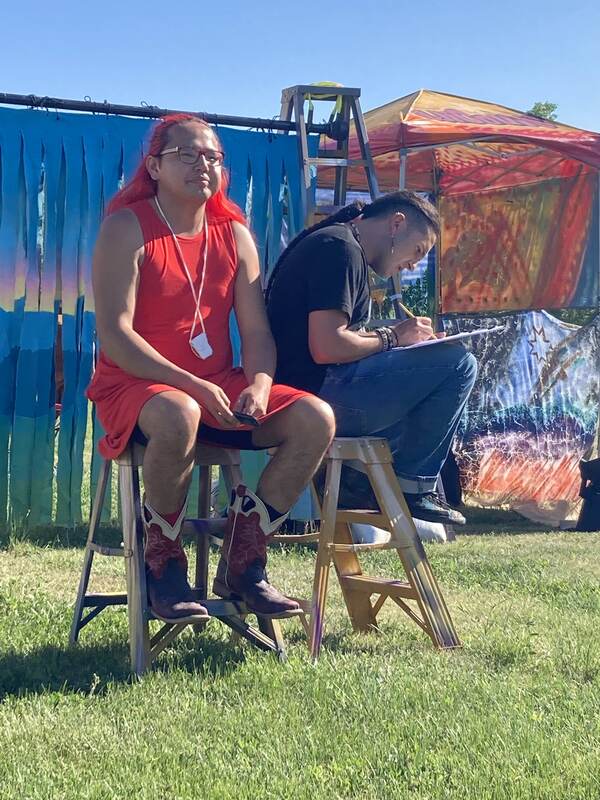
Ahí’s final monologue, while feeling natural to 9A in Lakota, is also poignant because, as the character stands as the man he’s become, 9A experiences the moment as “part of the goodbye of owning that [masculinity] fully in order to move on from it. As a trans person, I never despised having a male body or hated men or anything. All I ever wanted was to see our men be healthy and prosper and get better and work through their stuff.”
She sums up the remarkable convergence. “It’s just sort of beautiful how I’m reconciling my transness and figuring out being Oglala Lakota and everything else—that I’m having this opportunity of my first paid acting gig playing a trans lead character written by the first Native woman to get a play on Broadway. That doesn’t feel subtle.”
I think back to the community story circle, where her answer to the prompt “My superpower is…” was, “I feel powerful when…I just am, when I’m me, exactly as I’m supposed to be. When I embrace myself to a T and others match me.”
Brandon Makes History
The first performance of the state-wide tour is scheduled for three days after the Main Square thunderstorm. The company has relocated to the hotel and casino in Rosebud and will perform in Ft. Thompson, part of the Crow Creek reservation, where the youth workshop had been canceled without explanation. This is Brandon Sazue’s home, and it promises to be his big day.
The notice for Wicoun auditions leapt out at him from the website of Sinte Gleska University. Brandon is a student, along with his 29-year-old daughter, at Lower Brule Community College, an arm of Sinte Gleska. Though he’d never acted before, he thought, “I could do this. I can do this.” He took a break from his day job as a school janitor and, because he also drives a school bus, drove home to audition on Zoom. He auditioned for Elder Superhero, even though, at 49, he doesn’t feel like an elder yet. So he was happy to be cast as nerdy Chris. With his wife’s blessing, he took the job.
He had a powerful instinct to do the play—an intuition that it would change his life, and help him recover from several recent hellish years that began, I later learn, at the Standing Rock protests in 2016. As thousands of Indigenous protestors from dozens of tribal nations gathered to halt the Dakota Access Pipeline that would deliver oil from North Dakota to Illinois, Brandon worked the encampment, driving people everywhere, working so hard to support the ongoing gathering that he missed seeing “all the famous people who came.” When police violently broke the protests, he was arrested and put into prison. “I was so broken,” he says, though he keeps details to himself. “I did so many great, awesome things in my life. Then Standing Rock happened and everything went to shit after that.”
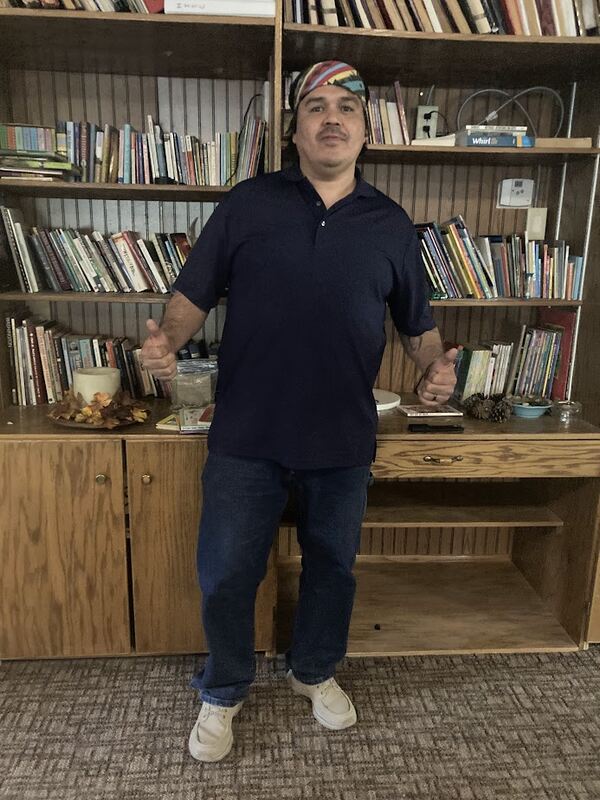
The play, he explains, “is giving me my life back. Giving me something to look forward to, to live for, something to inspire myself to say, I can do this—just to think about something else, being in a different world.”
The night before the Crow Creek performance, we’re talking in the room we share at the Quality Inn. He’s already told me about his military service as a young man and being discharged early for drunkenness, a past he’s surmounted. He doesn’t linger on his three terms as tribal chairman, though he does say, “Politics will eat you alive.” He currently works seven days a week at three jobs. Having been a paraprofessional in an elementary school, he switched to being a janitor to earn 30 or 40 more cents an hour—and then, days later, the pay scale for paraprofessionals jumped to $20 an hour, over $4 more than he makes as a janitor. He also drives a school bus and will soon test for a commercial license so he can drive larger buses. Weekends he serves as a kind of dorm parent for the boarding students. On top of this, he’s father to five children from a first marriage, including the daughter he will graduate beside two months after the tour ends, and 4-year-old twins at home with his second wife.
But tomorrow he’ll return to his community as an actor. “They think of me as a janitor, but tomorrow they’ll see I’m an actor.” He is so proud, and it’s infectious. “We’re making history. Nobody’s ever brought theatre to the tribes like this. Ever. After we’re there and gone, then people are going to realize: Holy shit. Of course the first Native American woman on Broadway was there. Yeah.”
The show takes place on a grassy lot between the offices of the Crow Creek Sioux Tribe, local home to Great Plains Tribal Leaders Health Board and the Tribal Opioid Response project, among others, and the larger hangar-like building where Brandon spent three two-year terms as chairman. It’s a hot day, so the audience of just under 30 people plant their chairs in the shade alongside the office building, which means the actors will have to skew stage left throughout. The show holds for half an hour. (Brandon is used to folks here showing up an hour late.) The volunteers from the Opioid Response project hand out popcorn and “Reach for Life” bags containing flyers and wrist bands embossed with a suicide prevention hotline number.
Brandon’s performance seems particularly strong today, confident. The laughs on the reservation erupt at different moments than in Rapid City and Custer. (There’s a “Rez dog” sound cue the audience loves, as they do Wóohitike’s offer to crush the Rapid City cop who harasses Áya and Khoskalaka.) When Brandon is onstage his twins, who turned 4 the day before, settle and watch him, transfixed.
He and I ride back to Rosebud with Michael and Larissa that night, stopping for dinner at Mi Pueblo in Chamberlain. From 9:30, when we leave the restaurant, until midnight, when we arrive at the hotel, the skies are full of the most intense lightning display I’ve ever seen: 180° of sky lit by a constant crash of zigzag, horizontal, devil-fingered, and full-sky bursts. Brandon claims this extreme weather is common here, but we marvel and gasp. I watch his calm face in the storm as a way of stilling my own panic. At each electric blast, Larissa lets out a demonic laugh, watching gleefully out the passenger window. As the rain begins and swells, Michael pulls over, and they switch seats.
When we reach our hotel, Brandon confesses that the lightning storm raged on longer than any he remembers. (“It was terrifying,” I say, still shaking.) He quietly notes that city drivers—i.e., Larissa and Michael—drive much faster in the rain than locals would to keep from hydroplaning. (I’d been thinking the same thing, as I watched the speedometer in mounting dread.) None of it fazed him, though. He’s feeling great about the day. He heads to the casino to see if his luck will hold, determined to make only coin-sized bets. I head to bed, my stomach in vomitous knots.
Once in bed I feel drops of water on my face and realize it’s raining into our Quality Inn room. (It’s raining into other rooms too, I later discover, the rez franchise being low on the hotel chain’s list of priorities.) I make my way to reception to ask for a room change and then to the casino to let my roommate know. Brandon’s sitting at a slot machine aglow. His great day just got greater: He just won $500 on a quarter bet. He exits alongside me and doesn’t return to the slots all week.
This is what he says: “Bringing the theatre to Crow Creek, to my hometown, coming back to the casino and winning $500—it just doesn’t get any better than that. We made history.”
The Sense of an Ending
At the heart of this story: a 10-year collaboration between a playwright and director, and the end of an even longer collaboration between that director and an ensemble.
On that windy night at Racing Magpie, the second performance of Wicoun, Michael John Garcés, a different kind of hero, earns his cape. It’s a blue-and-white star quilt, really, presented in a surprise ceremony before the second show begins. Larissa, Kenny, and Clementine drape it over his shoulders in recognition of all the work he’s done to give theatrical voice to the Indigenous people of the U.S. This tour, this show, will be Michael’s final production as artistic director of Cornerstone, 17 years after he took the job. Two weeks after the tour ends, he will step down.
Michael’s quilt was commissioned from Gladys Thunder Hawk-Gay, a local artist and grandmother of design consultant Tosa Two Heart. Coincidentally, the colors match the star quilt Larissa has at home. It’s not surprising. There’s a striking symbiosis in their relationship, a collaboration of a decade that has extended beyond the trilogy to productions of Larissa’s other plays at regional theatres, including one scheduled for the Guthrie in Minneapolis and one at L.A.’s Center Theater Group. (This latter show gets canceled, along with the entire season at CTG’s Mark Taper Forum, just as Wicoun concludes.) They’ve also both been appointed as professors of practice at ASU for the coming year.
Long-term playwright-director collaborations develop their own brand of intimacy and openness. Add to that tens of thousands of miles on the road, in shared community and housing, navigating perpetually new circumstances, and you have a constant conversation-in-progress. “Some spoken and some not,” Michael says. “We work together pretty instinctually at this point.” What he calls the “fluidity” of their collaboration means “we don’t really define the separation between church and state, between writer and director quite so concretely.” The credit on Wicoun, as on the other two projects, reads “By Larissa FastHorse In Collaboration with Michael John Garcés.”
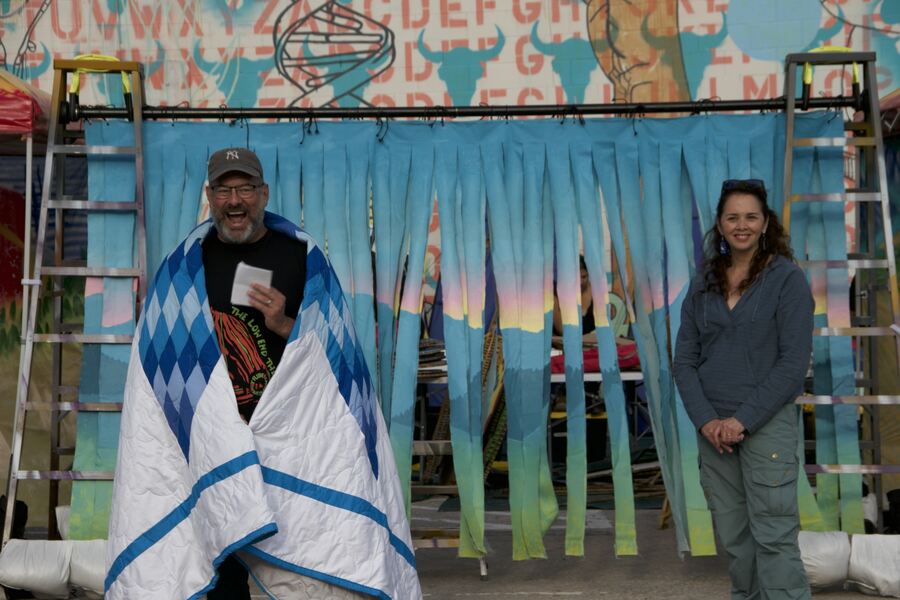
What started with Michael as artistic director, then director of her work—he directed all three of her Native projects with Cornerstone, though he wasn’t originally slated to do so—became a process and partnership that “just keeps growing and deepening as we go,” according to Larissa. It also keeps changing. By way of example, she jokes, “I found out that he can type 10 times faster than me. He hid that from me for many years. Now he gets to do the typing.” They are currently writing things together.
Through miles and hours in cars, stockpiling favorite candy and sharing meals on the fly, listening to rock ’n’ roll of different eras, replaying inside jokes, disparaging each other’s musical tastes, their relationship emanates the snarky, loving codependence of brilliant siblings forced to share a bathroom well into their 50s. They know each other too well.
When Michael struggles to describe the “particular feeling” of coming to the end of his time leading Cornerstone, Larissa offers a word: “Poignancy?”
“Yeah, poignancy,” Michael responds. “It feels emblematic of my tenure at Cornerstone to be doing my last project in South Dakota, a project that virtually nobody in L.A. will ever see. And yet the methodology is at its purest, and also the commitment to mission is at its purest.”
Why is it emblematic to do the final show where people in L.A., Cornerstone’s home base since 1994, won’t see it?
“It’s just not an L.A. show,” Michael says. “I didn’t go to Cornerstone to further my career. I had a career. It wasn’t a steppingstone to something else. My time at Cornerstone has been about deepening connection to community.”
Larissa elaborates: “This is only going to be for a few weeks. Except for a couple of friends, the only people going to see this are actual community members. Peter’s been talking about how this is the most Cornerstone work Cornerstone is doing. It’s not trying to be anything but community-serving. This is the stuff that makes me the happiest. It fulfills me the most. Also I feel like it’s actually doing some kind of real good in the world—as much as you can with theatre.”
There has been, for Michael, the “sense of an ending” with Wicoun, and “moments of surprising emotion in saying goodbye to the ensemble as an ensemble member.” Still, a lifetime in theatre, building “an emotional framework” to deal with “having short-term, intense relationships in collaborations on- and offstage and then moving on to the next one,” has taught him how to say goodbye. It has also taught him to focus on the work ahead. “There’ve been a lot of beginnings in my life lately. I got married in September, and I became a grandfather recently. I’ll be writing another play for Cornerstone in Portland, though not as artistic director. I feel like I’ve accomplished what I wanted to. If I could have known coming in that my tenure would have been this, I would have felt pretty fucking happy about it.”
Larissa, on the other hand, doesn’t know if, after these three projects, she’ll be invited to work with Cornerstone again. She’s not an ensemble member, and the future direction of the company will depend on the next artistic director. Michael’s departure, however, won’t affect their ongoing work. Their engagement in South Dakota will also continue, including, they hope (and plan to fundraise for) a return of Wicoun. To that end they have stored all the scenery and puppets.
“I talk to Cornerstone folks and realize they’re having a different moment than he and I are,” she says. “We’ve got a lot more work to do this year and next, and we’re continuing in South Dakota, so it’s part of a continuum for the two of us. In terms of collaborating together, it doesn’t feel like the ending of anything.”
Contrast this with Kenny Ramos, who has figuratively and often literally been along for the 10-year ride with Larissa and Michael. As part of the American Indian Community Council of Los Angeles, Kenny first met Larissa and the Cornerstones at a Council meeting and later in the week joined a story circle that would lead to Urban Rez. Disenfranchised by a “racist American theatre,” he had stopped acting and managed a program called Retention of American Indians Now! (RAIN! for short) at his alma mater, UCLA. Soon he was working as a community partner and then as an actor in the show. Ensemble membership in Cornerstone followed, while making Native Nation. He has since been a major connector in each new Native community, a kind of pan-tribal matchmaker, finding friends or friends of friends everywhere they go, bringing more and more Native people into their orbit. “Now I’m like, ‘Wait, Mom and Dad are leaving?’”
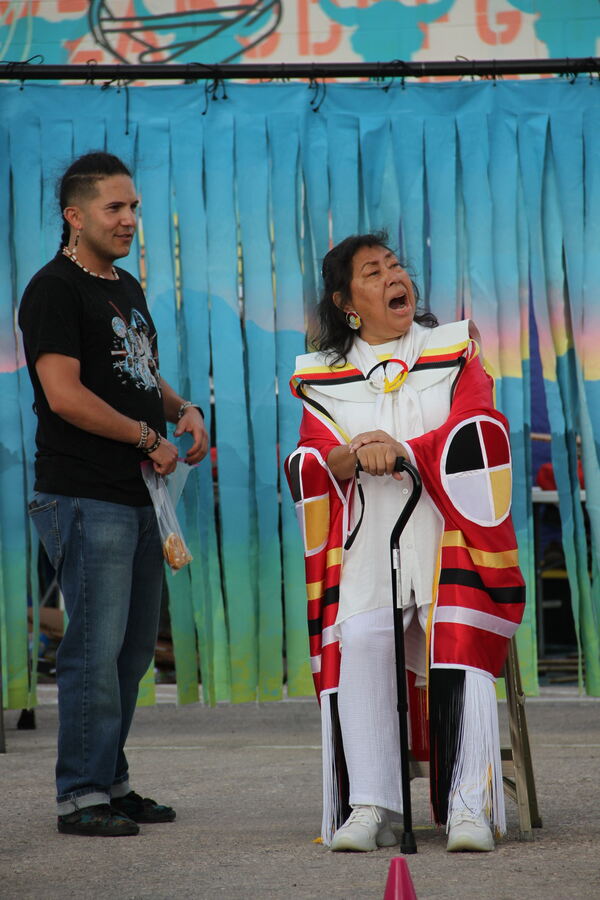
He’s excited to see what the company’s next chapter is, but he’s especially “passionate about the work in Indigenous communities, which has been very specifically with Michael and Larissa,” he notes. “As challenging as this is, touring around South Dakota, I would love to do this in all kinds of tribal communities. Let’s go to all the villages in Alaska. How crazy and hard would that be? Can we fit it all on a little plane and, oh my God, do it in winter? Can our cardboard sets last on ice?”
For Kenny the “good” Larissa speaks of them doing with theatre lives in the realm of “sovereign justice. People talk about social justice a lot,” he says, “and I think with American Indians it’s different. Our sovereignty is at the center of how our communities operate and also at the center of how our communities experience what it is to live in the United States, a nation-to-nation relationship.” Sovereign justice, then, is “all about our ability to govern ourselves, to determine our futures, to create nations that thrive, that are centered on our values.” What will the future of this work be for him as an actor-activist now that Mom and Dad are moving on?
When I ask Michael and Larissa the question they’ve asked hundreds of others—what is your superpower? —Michael, in the front passenger seat, grows mum. The silence stretches on. I threaten, “I know you guys don’t want me to write, ‘They ask people questions they’re unwilling to answer themselves.’”
Michael says, “One of my superpowers is my intransigence.”
Larissa leaps in: “His ability to make endless jokes out of poor grammar,” adding, “I was naming his superpower. My superpower is describing Michael’s superpower.”
“He has better ones,” she says, getting real. “It’s beautiful to watch how you uplift people and they don’t know it.”
If 9A’s comments are any indication, others do know how much Michael does. “What I’ve loved about Michael is that he’s put an effort to actually show he cares,” 9A tells me. “It’s cool to see, especially from somebody on the outside of my community. Just being fully cognizant of how much trauma there is, but also of what we can do and our own resilience when our backs are against the wall.”
What makes Michael feel powerful? His jaw clenches and he crosses his arms. He looks out the window.
An antelope runs in front of the car, and we wait.
Michael speaks: “I’ve spent the last 17 years at Cornerstone getting away from the paradigm of feeling powerful. I’m a six-foot tall, straight, white-presenting dude in the United States. I came to Cornerstone because I was sick of the power dynamics in rehearsal rooms and bored with it. I try to do a lot to shift the power dynamics of any creative situations I’m in.
“That’s why we have an ensemble, right?” he continues. “And that’s why we do the work in this way. You don’t come to South Dakota to do a play with community to feel powerful, honestly. There is feeling powerful when you are part of a collective of people doing a project because they want to do it. That is a very powerful feeling, of collectivity in power. You can be a conduit to doing something beautiful.”
Larissa elaborates. “When you and I are standing backstage in the dark somewhere, and the community is out there, and they don’t need us anymore—I guess that’s what I would call powerful. That’s when I feel good, when we’re not needed anymore. When they are telling their stories and their strength and their passion and their way and their confidence, and we are forgotten somewhere in the dark in the back. Really, that’s the best moment. We could just walk away and they wouldn’t ever notice.” In other words, the greatest superhero is the one who can walk away, while those who remain have the power to save themselves.
Summer 2023
The tour ends on June 16 at the Cheyenne River Youth Project Art Park in Eagle Butte. There are too many stories to print here. Some I witnessed, like the night Michael, Kenny, Larissa and I stopped in at the bar outside our motel in Kennebec and a woman, hearing the name FastHorse, introduced herself and revealed she used to live with Larissa’s grandfather; she’d had two children with him.
Or stories I heard: how kindly Peter Howard spent 15 minutes in a police car outside Wagner in 5° weather, getting background checked on the suspicion that, like his character, he was running drugs or human trafficking, a problem with white outsiders in rental cars in this region. He told the officer about community-engaged theatre, discovered they shared a birthday, and got released with a warning for driving (a little) too fast.
And of course all the stories of the performances and the people who came to see them, the people who almost auditioned, then backed out, or who auditioned and couldn’t do the play because this or that happened. Stories of how the actors felt at each new destination, especially, like Brandon, when they played at home. Christopher Alexander Piña, whose Lakota name is Generous, said that everyone has a story and is one. So many stories converge in this work, each needing to be told.
Larissa, whose superpower is “seeming trustworthy,” knows this in her writerly bones. “For some reason people feel the need to tell me their life story,” she muses. “People on the bus, people in the store.” This attentive approachability is very useful in her work. Though she’s an introvert, she’s able to talk to strangers and inspire them to “tell me very long, very intimate stories about themselves. I’m very honored that they do.” Because she actually is trustworthy, she in turn feels “a lot of responsibility in holding these stories.”
In an email to the company, she tries to express “how emotional it makes me to hear Lakota being spoken every day while standing under Lakota paintings and wearing Lakota clothes on L/Dakota actors. It’s a dream I’ve had for a very long time. Wopila for making it come true—not for me, but for all L/Dakota people who are invisible or feared or persecuted or struggling or successful on our homelands. Wopila for helping us be seen. It’s the best of what art, and especially Cornerstone, can do.”
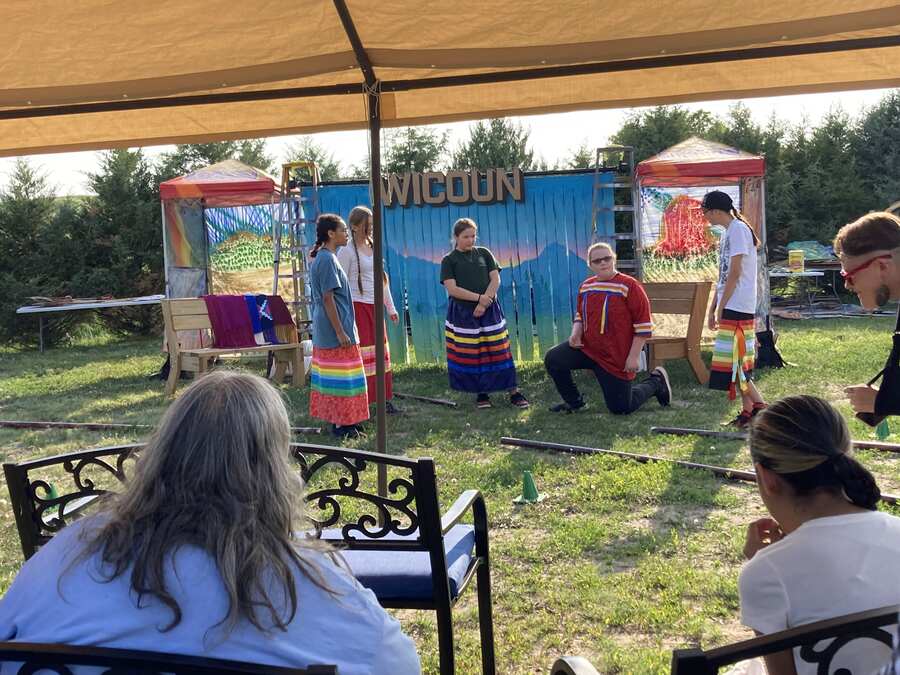
I left before the tour ended, so I ask her about the parts I missed. There’s so much more than she can put in an email: All the people who wanted the company to stay longer or come to their town, the show with 12 dogs, how “bizarre and special” it was to play in her hometown “with people from all parts of my life in one place.” 9A already landed her next acting gig, as Danny in Bear Grease. “I wish you could have been there for all of the kids,” she writes. “They are the most amazing part of this.”
Children have been central to Larissa’s lifelong project from the days when she came back, barely out of high school, to lead dance and writing classes, to the recent summers at Lakota Youth Development. In June, she helped arrange a New York trip for the kids from LYD to see The Thanksgiving Play on Broadway, where they met with the cast, attended & Juliet, and toured city sights. They not only saw the city for the first time; they saw the first play by one of their own, a Lakota woman—someone they know—on Broadway.
Running parallel to Wicoun, Larissa and Michael scheduled as many youth workshops as possible at stops along the way. Some never happened, as in Crow Creek, or had to be scaled back after, for example, a car got stuck in the prairie sand. Each was, as Michael puts it, “its own very particular adventure.” Originally, as Tony Awards season approached, it seemed likely that Michael would be leading these alone, so that Larissa could be in New York. When The Thanksgiving Play went inexplicably unnominated, it meant that Larissa would not only be present at all the tour shows, but that she could join Michael and the kids. At a May staff huddle, she quipped: “The upside of not getting a Tony is that I can now force 7-year-olds to write plays.”
They create a show with LYD early in rehearsals, Learning Wolakota—another superhero piece with a lot of Milks Camp history in it. They have the concept for another short play, a template to be workshopped briefly in visits to some of the tour spots. They will have the children insert their own stories and perform it as a staged reading. Ultimately it’s presented only at Marty Indian School on the Yankton Reservation (also a future performance site), thanks in large part to Dakota elder Faith Spotted Eagle, and in Eagle Butte before Wicoun.
In Rapid City the night of the rainstorm, Larissa talks to a little boy who is tearing around Main Street Square on his Razor scooter. She invites him to the play, telling him it’s about Lakota people.
“I mean, his face—just the concept of it happening in his town was incredible,” she recounts. “But I’m Lakota!” she says he cried. “He was not a child who had the capacity to sit still and watch something, but he couldn’t leave until the rain drove us all away. Seeing his face and the way it lit up, and seeing that again and again in the shows we’ve done for Lakota people, because of the incredible invisibility we have here—invisible in plain sight—it’s really beautiful. A little person who does not even understand what a play is, but couldn’t leave because it was about Lakota people and that’s who he is.”
The children have always been at the heart of this project, this story. They are the heart because they are the future: the camp kids emerging from their hoodies to run around as prairie chickens who are really ducks, the little girl at Racing Magpie laughing at “No sugar!” while waiting for her permanent teeth, the LYD kids at a Broadway play by their own teacher, the boy on the Razor.
The name of the play Larissa and Michael dream up for the youth workshops? The Further Adventures of Ahí.
Todd London (he/him) is a former managing editor of American Theatre and the author of numerous books on the theatre, including This Is Not My Memoir with Andre Gregory, An Ideal Theater, Outrageous Fortune, The Importance of Staying Earnest, and The Artistic Home, as well as two novels, If You See Him, Let Me Know and The World’s Room. A long-term artistic director of New York’s New Dramatists, he won the George Jean Nathan Award for Dramatic Criticism and was the first recipient of Theatre Communications Group’s Visionary Leadership Award.

